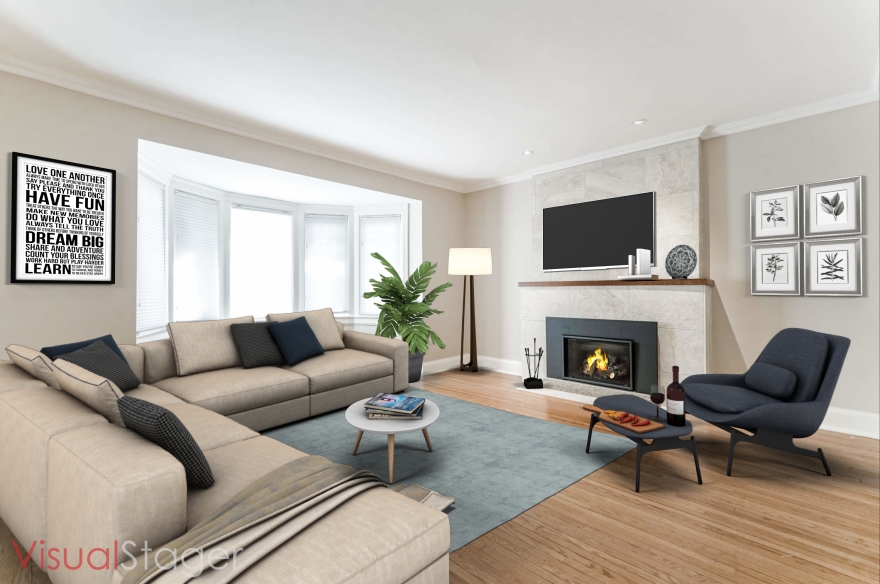Virtual staging offers benefits over physical staging. It’s less expensive, easier and faster.
As with physical staging, virtual staging differs from decorating. Staging creates a narrative of the life that goes on in the home, says real estate agent Lynn Tribbling of Right At Home Realty in Toronto, who with the help of graphic production artist David Pearcey, has been staging virtually for years
In 2015 when they started working together, Pearcey says he and Tribbling would sometimes spend days working on Photoshop. He imagined how great it would be to have software that would allow the user to pick up furniture, rotate it and plunk it down into a virtual space. Now that software exists and Pearcey is using a sophisticated yet easy-to-use system that automatically sizes furniture to each room’s dimensions.
It all starts with photographs and room dimensions. The better the quality of photography, the better the finished product. However, in these times a homeowner could take photos on their cell phone and send them to their agent to ensure physical distancing. Pearcey says generally one photo is enough per room unless the agent or client wants to show the room from different angles.
Photos should be taken with a regular lens, not a fisheye or other type of lens that will distort the picture.
It’s a non-invasive and hygienic way to show your home to potential buyers, Tribbling says. And it’s easy. There’s no moving furniture in and moving it back out after the house sells. And with condominium suites, it makes the process so much easier. “Condo staging is like a military operation. You have to book time with the concierge, book the elevator and the movers.”
When Pearcey receives Tribbling’s photos, he manipulates the 3D products (furniture and accessories) selected from a wide range of choices his software package provides, rotates and then places them. Sometimes he Photoshops pieces to add features such as shading to make the space look more realistic.
Pearcey says the software is easy for homeowners to use, but he cautions it is best left to the pros because rooms need to be staged to attract the people who will most likely buy a home. Agents know how to do that, he says.
For example, Tribbling says in a home marketed at first-time buyers, the dining room may be staged as an office. However if marketing to empty nesters, the room is staged as a dining room because it’s where the family gathers on special occasions.
She says it’s important to retain a virtual staging company or tech specialist who has real estate experience.
“Realtors can Google various online services, paying particular attention to sample portfolios. If the Realtor is extremely computer savvy, they can try the software themselves but risk creating an amateur result, which defeats the purpose of showcasing a home in the best light.
“It’s also important to have design options. Some services just provide stock renderings with standard furnishings. They are decorating the room, not staging it. Decorating makes a room look pretty. Staging tells a narrative and targets a specific type of buyer. Top-quality real estate virtual staging involves two different skill sets: software competence plus market awareness of the likely purchaser and their lifestyle. When in doubt, virtual staging can render different design options for the same room to appeal to a wider swath of buyers.”
Virtual staging is perfect for vacant homes. For homes that are furnished, it’s possible to edit clutter out, but it’s a costly process. The clutter must be air-brushed out and then the background recreated before new staging can begin.
Some software companies offer a service that virtually empties the furnished space and returns the empty room so it can be staged from scratch.
The downside of virtual staging is disappointment – potential buyers (when they can finally view the property in person) may be disappointed when they expect to see a glamorous space and instead see an empty room, Tribbling says.
When using virtual staging, it’s important to clearly indicate that the work has been created virtually. She adds “concept” to each photo so it’s clear.
She also says it is unlikely potential buyers will form an emotional bond that they might if visiting the space in person.
Virtual staging costs around $50 to $100 per room versus about $500 for the first month for physical staging. Virtual staging is fast – the turn-around time is 24 to 48 hours per project (house or suite), says Pearcey.
This type of virtual staging software can also be used if you’re thinking of redecorating.
You can see exactly what your room will look like without physically moving a thing. For a condo redesign project Tribbling worked on, she says it was much easier to put different chandeliers into a virtual lobby rather than physically ordering them to see which looked best.






